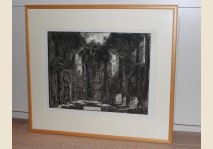Currently Shopping by:
- subject: Architectural Remove This Item
Shopping Options
Giovanni Battista Piranesi (1720-1778)
 One of the greatest printmakers of the eighteenth century, Piranesi always considered himself an architect. He received practical training in engineering from a maternal uncle who was employed by the Venetian waterworks, while his brother, a Carthusian monk, fired the aspiring architect with enthusiasm for the history and achievements of the ancient Romans.
One of the greatest printmakers of the eighteenth century, Piranesi always considered himself an architect. He received practical training in engineering from a maternal uncle who was employed by the Venetian waterworks, while his brother, a Carthusian monk, fired the aspiring architect with enthusiasm for the history and achievements of the ancient Romans.
Whether or not Piranesi studied printmaking in Venice, it is certain that after his arrival in Rome in 1740, he apprenticed himself briefly to Giuseppe Vasi, the foremost producer of the etched views of Rome. Quickly mastering the medium of etching, Piranesi found in it an outlet for all his interests, from designing fantastic complexes of buildings that could exist only in dreams , to reconstructing in painstaking detail the aqueduct system of the ancient Romans. The knowledge of ancient building methods demonstrated by Piranesi's archaeological prints allowed him to make a name for himself as an antiquarian—his Antichità Romane of 1756 won him election to the Society of Antiquarians of London. Etching also provided Piranesi with a livelihood, allowing him to turn one of his favorite activities, drawing the ancient and modern buildings of Rome, into a lucrative source of income. By 1747, Piranesi had begun the work for which he is best known, the Vedute di Roma, and he continued to produce plates for the series until the year of his death in 1778. Piranesi returned to his native city twice in the mid-1740s, the very years in which Canaletto was producing his luminous etched views of Venice and Tiepolo was at work on his novel series of etchings. The series of labyrinthine prison interiors, the Carceri, was created soon after Piranesi's encounter with the lively printmaking scene in Venice. In these prints, Piranesi explored the possibilities of perspective and spatial illusion while pushing the medium of etching to its limits.
His Delle magnificenza ed architettura de'Romani date s from 1761. In his preface to the Diverse maniere d'adornare i cammini of 1769, with designs in the Etruscan, Greek, Roman, and even Rococo styles, Piranesi argued for the complete freedom of the architect or designer to draw on models from every time and place as an inspiration for his own inventions.
It seems that the artist's tireless devotion to his work and his identification with the grandeur of Rome never flagged, for on the day of his death, he spent his last hours busy among his drawings and copperplates. (...from the description by Wendy Thompson - Department of Drawings and Prints, The Metropolitan Museum of Art )










 Facebook
Facebook Twitter
Twitter Subscribe us
Subscribe us Flickr
Flickr




